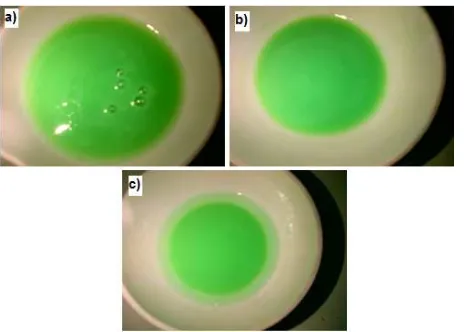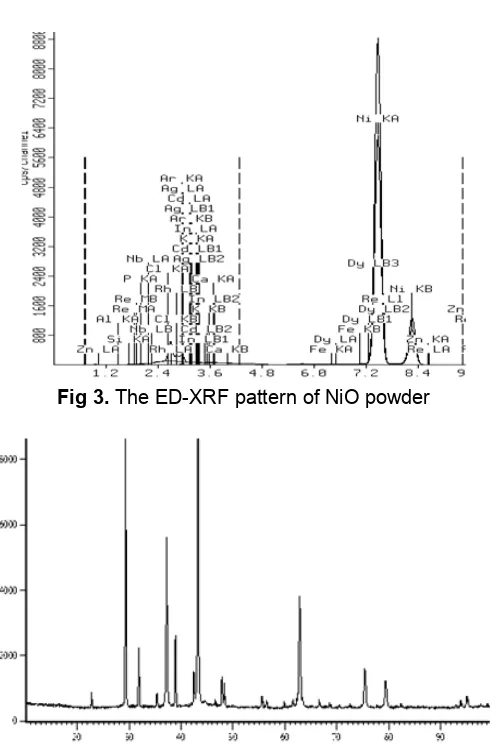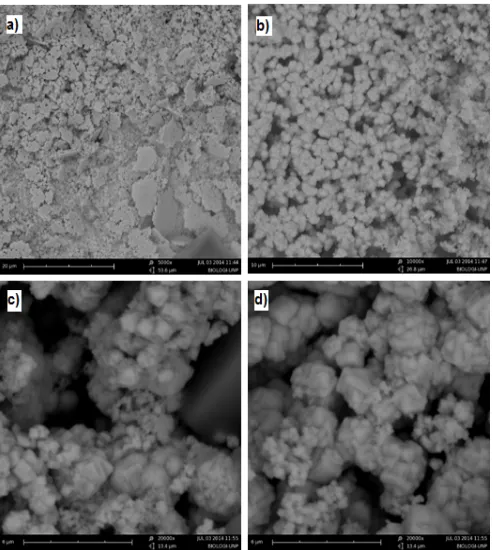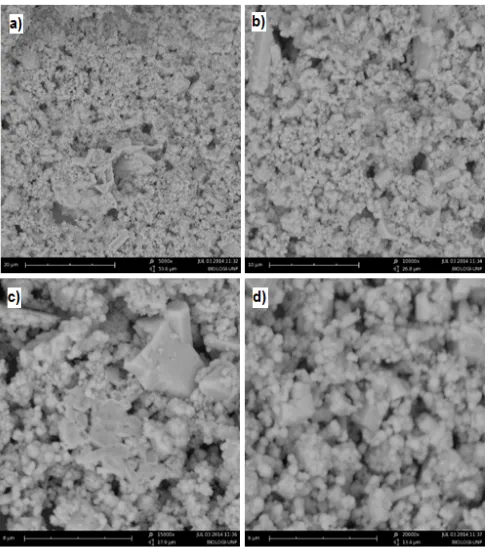and agent precipitator, respectively. The addition of various solvents that used in this research were aquadest, methanol and isopropanol. The powders were formed by drying in the temperature of 100-110 °C for 1 h and after heating at450 °C for 1 h. The products were obtained black powders. The products were characterized by Energy Dispersive X-Ray Fluorescence (ED-XRF), X-Ray Diffraction (XRD) and Scanning Electron Microscopy (SEM). The ED-XRF pattern show that composition of NiO produced was 96.9%. The XRD patterns showed NiO forms were in monoclinic structure with aquadest solvent and cubic structure with methanol and isopropanol used. Crystal sizes of NiO particles produced with aquadest, methanol, isopropanol were obtained in the range 37.05; 72.16; 66.04 nm respectively. SEM micrograph clearly showed that powder had a spherical shape with uniform distribution size is 0.1-1.0 µm approximately.
Keywords:nickel oxide; solvents; nanopowder; simple sol-gel; spherical
ABSTRAK
Sintesis nikel oksida (NiO) dengan variasi pelarut telah dilakukan dengan menggunakan metoda sol-gel sederhana. Nanopowder NiO didapatkan dengan menggunakan nikel nitrat heksahidrat dan natrium hidroksida 5 M sebagai prekursor dan agen pengendap. Variasi pelarut yang digunakan dalam riset ini adalah aquades, metanol dan isopropanol. Bubuk atau powder dihasilkan dengan mengeringkan pada temperatur 100-110 °C selama 1 jam dan setelah pemanasan pada suhu450 °C selama 1 jam. Produk yang dihasilkan adalah bubuk hitam. Produk NiO dikarakterisasi dengan menggunakan Energy Dispersive X-Ray Fluorescence (EDXRF), X-Ray Diffraction (XRD) dan Scanning Electron Microscopy (SEM). Pola ED-XRF menunjukkan komposisi NiO yang dihasilkan sekitar 96,9%. Pola XRD menunjukkan bahwa produk NiO memiliki struktur monoklin dengan penggunaan pelarut aquades, sedangkan NiO dengan struktur kubik dihasilkan dengan penggunaan pelarut metanol dan isopropanol. Ukuran partikel NiO yang dihasilkan adalah 37,05, 72,16, 66,04 nm dengan menggunakan aquades, metanol dan isopropanol berturut-turut. Mikrograf SEM memperlihatkan morfologi NiO dalam bentuk sperik dengan ukuran distribusi sekitar 0,1-1,0 µm.
Kata Kunci:nikel oksida; pelarut; nanopowder; sol-gel sederhana; sperik
INTRODUCTION
Nanoparticles are classified as being materials in which at least one dimensions of the material is less than 100 nanometers in diameter. Nanoparticles have unique properties, such as having increasing electrical conductivity, toughness, ductility and formability of ceramics. One of the most commonly used transition metal oxide with a wide range application for example NiO [1].
Nickel oxide (NiO) is a NaCl type antiferromagnetic oxide semiconductor with type p-type conductivity films due to its wide band gap energy range from 3.6 to 4.0
eV [3-4] that can be used in optical, antiferromagnetic film [1-2], electronic, catalytic, super-paramagnetic device [5], supercapacitors [6], gas sensors, alkaline batteries cathode, solid oxide fuel cell anode and in the manufacture of electrochromic [7]. NiO nanoparticles show many unique optical, electrical, magnetic and chemical properties [8]. NiO is one of the useful metal oxide and which has so many applications in different fields.
Fig 1. Sol of nickel oxide with various solvents a) aquadest, b) methanol and c) isopropanol
Fig 2. Gel of nickel oxide with various solvents a) aquadest, b) methanol and c) isopropanol
synthesis route [14] involved solid liquid separation, washing and drying process have previously been investigated for preparation of nickel oxide nanoparticles. Another process including microwave irradiation method [2] and [5], thermochemical processing [16], solvothermal method [17], liquid phase process, spray pyrolysis process, electroplating of nickel particle [6], metal organic chemical vapor deposition (MOCVD) [8] have a number disadvantages such as quite expensive, uses volatile compound and need complicated reactor. Many of the reported methods are limited to laboratory scale due to specific condition requires [16], low homogeneity, high cost, and complex apparatus.
This paper, the results of an investigation into the well dispersed NiO nanopowders by sol-gel processing with various solvents is presented. So-gel processes have many advantages such as high homogeneity, low-cost, simple apparatus and easily in processing. The various solvents that used in this research were aquadest, methanol and isopropanol. Nickel nitrate hexahydrate as precursor and sodium hydroxide as precipitator agent.
EXPERIMENTAL SECTION
Materials
The research has been focused on effect of solvents on morphology of nickel oxide nanopowders synthesized by simple sol-gel method. All the chemical reagents used in this experiment were of analytical grade and without further purification. The precursor used in this study was nickel nitrate hexahydrate (Merck), aquadest, methanol and isopropanol as various solvent, NaOH 5 M as precipitation agent.
Instrumentation
The synthesized NiO nanoparticle was characterized by the following. X-Ray Diffraction (XRD) with a diffractometer by using monochromatic CuKα with = 1.54060 was used for determination of crystal structure. Energy Dispersive X-Ray Fluorescence (ED-XRF) for composition analysis and morphological study was carried out by Scanning Electron Microscopy (SEM).
Procedure
Powders NiO synthesized by simple sol-gel method with solvents variation by using nickel nitrate hexahydrate from Merck as precursor, aquadest, methanol, isopropanol as solvent, sodium hydroxide as agent precipitator. To synthesize nickel oxide nanopowders, 2.0 M NaOH was added drop wise 20 mL of 1.0 M Ni(NO3)2.6H2O solution which was stirred
by magnetic stirring apparatus, under vigorous stirring the solution for 60 min at room temperature. Light green suspension was produced. It was then dried at 100-110 °C for1 h, the green powder was produced. The product then transferred to porcelain crucible and put in furnace at 450 °C for 1 h, and finally black powder produced.
RESULT AND DISCUSSION
Shyntesis of sol NiO was carried out by using nickel nitrate hexahydrate as precursor and with various solvents such as aquadest, methanol, and isopropanol. NaOH 5M added to solution as precipitation agent. The reaction can be seen below:
3 2 2 3 2 2
Fig 3.The ED-XRF pattern of NiO powder
Fig 4. X-ray diffraction pattern for NiO with aquadest solvent
Fig 5. X-ray diffraction pattern for NiO with methanol solvent
Fig 6.X-ray diffraction pattern for NiO with isopropanol solvent
Table 1.Crystallite size of NiO nanopowders Solvents Crystallite size (nm)
Aquadest 37.05
Methanol 72.16
Isopropanol 66.04
Fig. 1 depicts sol of nickel oxide with various solvents that produced by simple sol-gel method with NaOH as precipitation agent dried at 100-110 °C for 1 h in oven. The color of sol of nickel oxide was light green. The morphology of Ni(OH)2.6H2O was homogen (visual).
After heating process at 100-110 °C, the solvent will evaporate. Sol of nickel oxide that produced by aquadest solvent has homogeneity sol.
Fig. 2 shows gel of nickel oxide after dried at 100-110 °C for 1 h in oven. The light green was produced. Gel of nickel oxide that synthesized with aquadest shows homogenous and the solvents easily evaporate. Gel of nickel oxide that produced by using methanol is
more easily evaporated compared to gel of nickel oxide with isopropanol solvent.
The reaction can be seen below:
2 2 2 2
Ni(OH) .6H O Ni(OH) + 6H O
NiO was produced after calcination at 450 °C in furnace, the reaction can be seen below:
2 2
Ni(OH) NiO + H O
The black powder produced after calcination process at 450 °C for 1 h. The powder in visual was homogen, particle size was very small and light black.
Fig. 3 shows the ED-XRF pattern of NiO powder by simple sol-gel method. From this curve can be seen that composition of NiO is 96.904%, Al2O3 is 0.639%,
P2O5 is 0.873%. From this curve showed that
composition of NiO is highest.
Fig 7. SEM photograph of NiO particles produced with aquadest solvent a) 5000x, b) 10.000x, c) 15.000x, d) 20.000x
Fig 8. SEM micrograph of agglomerated nanopowders NiO particles produced with methanol solvent a. 5000x, b) 10.000x, c) 15.000, d) 20.000x
XRD analysis depicted that this substance is a typical monoclinic NiO (JCPDS No. 01-072-4521) and impurity of NaNO3 (JCPDS No. 01-079-2056). Impurity product
produced in this synthesis caused by NiO powder not washed with water and volume of NaOH that added very high. The final product appeared in black color. Fig. 4 indicates high crystallinity of NiO nanopowder.
Fig. 5 depicts the X-ray diffraction (CuKα radiation) spectrum of the black powder prepared by simple sol-gel process with methanol as a solvent. XRD pattern of NiO powder at temperature of 450 °C, the highest intensity with typical peak at 2 = 29.31; 37.18; 34.87; 42.46; 43.20; 47.82; 62.77; 75.30. XRD analysis showed that this substance is a typical cubic NiO (JCPDS No. 01-073-1523) and impurity of NaNO3 (JCPDS No.
01-079-2056). Impurity product produced in this synthesis caused by NiO powder not washed with water and volume of NaOH that added very high. The final product appeared in black color. Fig. 5 indicates high crystallinity of NiO nanopowder.
Fig. 6 illustrates the XRD pattern of the calcined product at 450 °C by simple sol-gel process with isopropanol as a solvent. XRD pattern of NiO powder at temperature of 450 °C, the highest intensity with typical peak at 2 = 29.36; 36.22; 37.11; 43.13; 62.64. XRD analysis showed that this substance is a typical a cubic NiO (JCPDS No. 01-089-7130) and impurity of NaNO3
(JCPDS No. 01-079-2056). Impurity product produced in this synthesis caused by NiO powder not washed with water and volume of NaOH that added very high. The final product appeared in black color. Fig. 6 indicates high crystallinity of NiO nanopowder.
According to Scherer equation, crystallite size generally decreases with broadening the longest XRD peaks. The mean crystallite size was calculated by the application of the Scherer equation:
. cos
K
D
where:
D is the mean crystallite size of the powder, is 0.15406 nm is the wavelength of CuKα,
is theFull Width at Half Maximum(FWHM) intensity of 2θ x (π/180),
is Bragg’s diffraction angle, and K is a constant usually equal to 0.89
The results are 37.05, 72.16, 66.04 nm for the various solvent were aquadest, methanol, isopropanol (Table 1) respectively. It means that the aquadest is the best solvent in preparation of NiO nanoparticle.
Fig 9. SEM photograph of NiO particles produced with isopropanol solvent a) 5000x, b) 10.000x, c) 15.000x, d) 20.000x
clearly seen that the NiO nanopowders are mostly regular shaped. The range particle size vary between 60-70 nm are observable in the figure. From the SEM analysis, the microstructure of NiO nanopowder wasproduced in spherical form. Fig. 7a-d shows the highly aggregated spherical nanoparticles.
Fig 8 depicts the photo SEM of NiO nanopowder that characterized by using simple sol-gel method with methanol as solvent. It is clear that in all cases, NiO nanopowder was successful prepared by simple sol-gel process. The range particle size vary between 60-80 nm are observable in the figure. From the SEM analysis, the microstructure of NiO nanopowder was produced in spherical form. Fig. 8a-d shows the highly aggregated spherical nanoparticles.
Fig 9 depicts the micrograph SEM of NiO nanopowder that characterized by using simple sol-gel method with isopropanol as solvent. It is clear that in all cases, NiO nanopowder was successful prepared by simple sol-gel process. It can be seen that the surface of NiO using the isopropanol solvent is more homogeneous and regularity in particle size compared with the other particles. The particle size of the isopropanol solvent product is smaller than methanol solvent. The range particle size vary between 50-60 nm are observable in the figure. From the SEM analysis, the microstructure of NiO nanopowder was produced in spherical form. Fig.
with black powder. The crystallite size of NiO nanopowder calculated by Scherer Equation. The crystallite size of NiO nanoparticles were 37.05 nm, 66.04 nm and 77.05 nm for aquadest, methanol and isopropanol, respectively. The structure of NiO nanopowder with aquadest solvent was a monoclinic type. The structure of NiO nanopowder with methanol and isopropanol solvents was cubic type. Micrograph of NiO nanopowders were spherical form with diameter size in range 90-100 nm. Aquadest solvent is the best solvent for synthesized NiO by simple sol-gel method.
REFERENCES
1. Anandan, K., and Rajendran, V., 2012, Nanosci. Nanotechnol., 2(4), 24–29.
2. Al-Rasoul, K.T., 2012, Asian Trans. Basic Appl. Sci., 2(2), 1-8.
3. Mazaheri, M., Zahedi, A.M., and Hejazi, M.M., 2008,Mater. Sci. Eng., A, 492(1-2), 261–267. 4. Bahadur, J., Sen, D., Mazumder, S., and
Ramanathan, S., 2008, J. Solid State Chem.,
181(5), 1227–1235.
5. Mohammadyani, D., Hosseini, S.A., and Sadrnezhaad, S.K., 2012,Int. J. Mod. Phys. Conf. Ser., 5, 270–276.
6. Junqing, L., Jingli, S., Xi, Y., Xiaoling, Z., Zechao, T., Quangui, G., and Lang, L., 2012, Int. J. Electrochem. Sci., 7, 2214–2220.
7. Mahaleh, Y.B.M., Sadrnezhaad, S.K., Hosseini, D., 2008,J. Nanomater., 10, 1–4.
8. Moravec, P., Smolik, J., Keskinen, H., Mäkelä, J.M., Bakardjieva, S., and Levdansky, V.V., 2011,
Mater. Sci. Appl., 2, 258–264.
9. Wei, Z., Qiao, H., Yang, H., Zhang, C., and Yan, X., 2009,J. Alloys Compd., 479, 855–858.
10. Meybodi, S.M., Hosseini, S.A., Rezaee, M., Sadrnezhaad, S.K., and Mohammadyani, D., 2012,
Ultrason. Sonochem., 19(4), 841–845.



